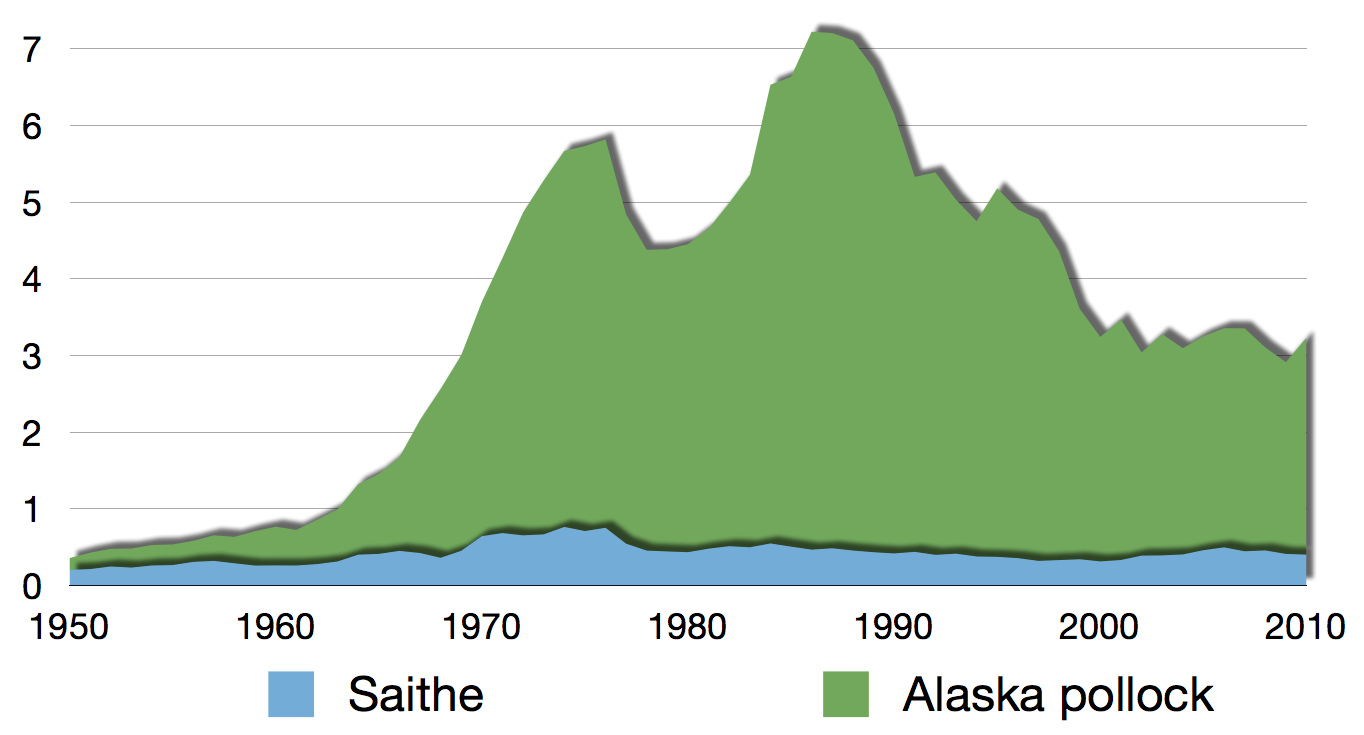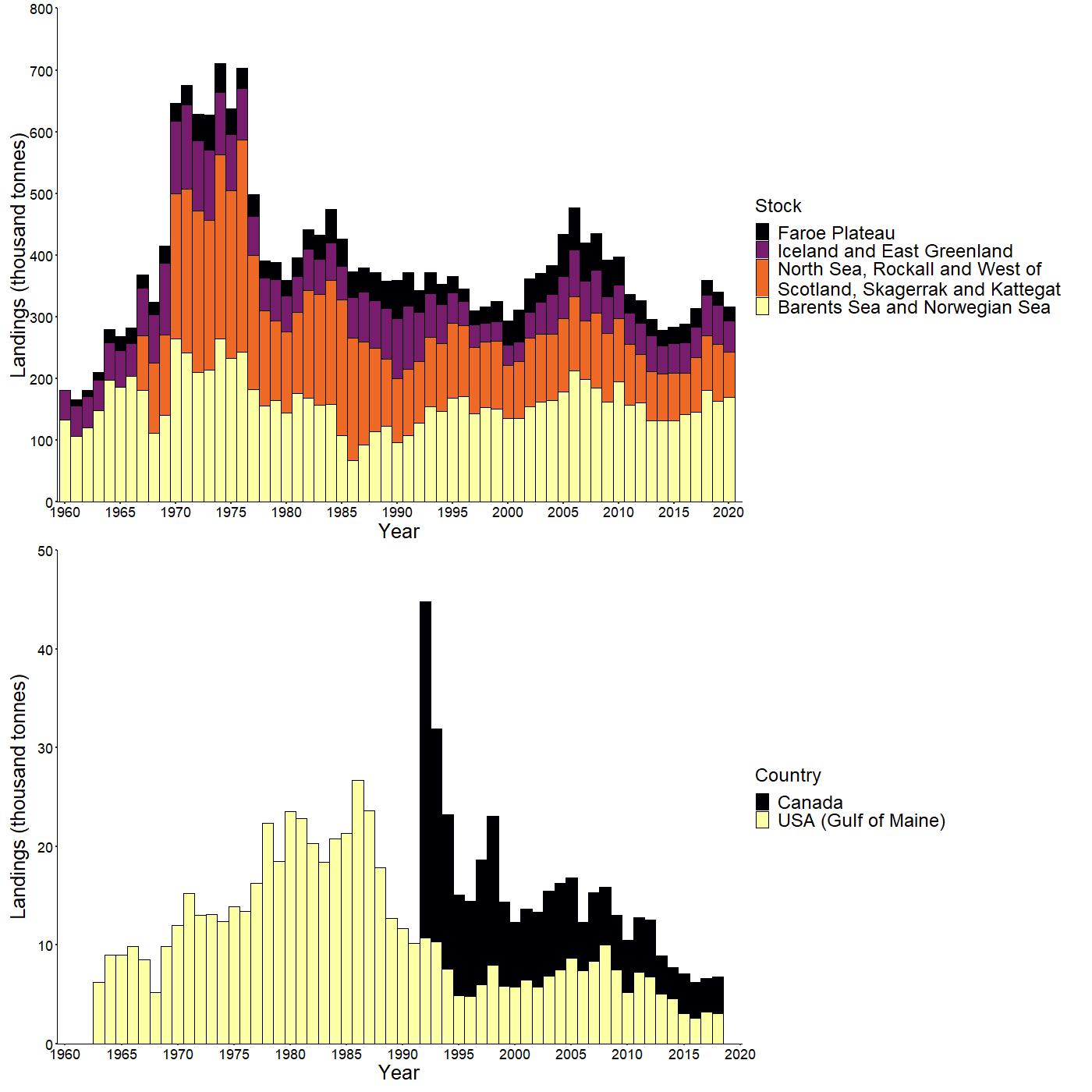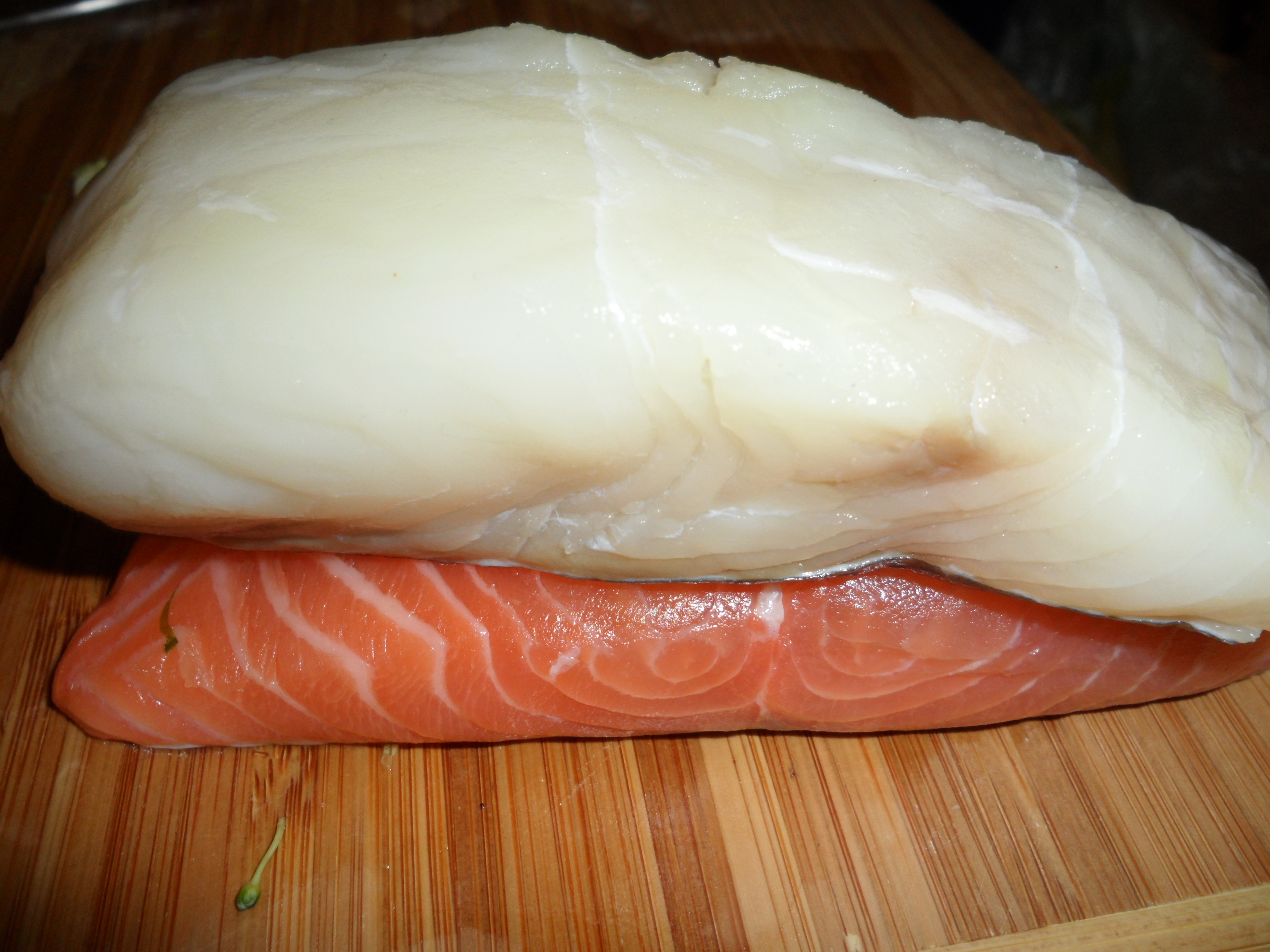|
Pollock
Pollock or pollack (pronounced ) is the common name used for either of the two species of North Atlantic marine fish in the genus ''Pollachius''. '' Pollachius pollachius'' is referred to as pollock in North America, Ireland and the United Kingdom, while ''Pollachius virens'' is usually known as saithe or coley in Great Britain and Ireland (derived from the older name coalfish). Other names for ''P. pollachius'' include the Atlantic pollock, European pollock, ''lieu jaune'', and lythe; while ''P. virens'' is also known as Boston blue (distinct from bluefish), silver bill, or saithe. Species The recognized species in this genus are: * '' Pollachius pollachius'' (Linnaeus, 1758) (pollack) * ''Pollachius virens'' (Linnaeus, 1758) (coalfish) Description Both species can grow to and can weigh up to . ''P. virens'' has a strongly defined, silvery lateral line running down the sides. Above the lateral line, the colour is a greenish black. The belly is white, while ' ... [...More Info...] [...Related Items...] OR: [Wikipedia] [Google] [Baidu] |
Cod As Food
This article is about cod and other cod-like fishes from the family of Gadidae, such as haddock, pollock, and whiting, regarded as food. Cod Cod is popular as a food with a mild flavour and a dense, flaky white flesh. Young Atlantic cod or haddock prepared in strips for cooking is called scrod. Cod's soft liver can be canned or fermented into cod liver oil, providing an excellent source of vitamin A, vitamin D, vitamin E and omega-3 fatty acids (EPA and DHA). Cod flesh is moist and flaky when cooked and is white in colour. In the United Kingdom, Atlantic cod is one of the most common ingredients in fish and chips, along with haddock and plaice. Cod can be easily turned into various other products, such as cod liver oil, omega pills, etc. Other cod-like fish Haddock Haddock is a very popular food fish, sold fresh, smoked, frozen, dried, and, to a small extent, canned. Haddock, along with cod and plaice, is one of the most popular fish used in British fish and chips. ... [...More Info...] [...Related Items...] OR: [Wikipedia] [Google] [Baidu] |
Atlantic Pollock
''Pollachius pollachius'' (Atlantic or European pollock) is a species of marine fish in the '' Pollachius'' genus. FAO uses the English name pollack for this species. Together with ''Pollachius virens'', it may also be referred to as pollock. Other names include European pollock, ''lieu jaune'', lythe and in the Isle of Man, callig . It is common in the north-eastern parts of the Northern Atlantic, including the Bay of Biscay and North Sea. Adults can grow up to and weigh up to , although more commonly their maximum length is . Ecology and life history Pollack are fast-growing and relatively short-lived. The maximum reported age is 15 years. They are said to spawn offshore, although their spawning grounds are poorly known; a study of a fjord population in Norway suggested local spawning. Pollack are benthopelagic, that is, they live near the sea floor. They seem to be relatively sedentary. Fisheries Pollack is of value to fisheries, although it mainly represents bycatch. Landi ... [...More Info...] [...Related Items...] OR: [Wikipedia] [Google] [Baidu] |
Pollachius Pollachius
''Pollachius pollachius'' (Atlantic or European pollock) is a species of marine fish in the '' Pollachius'' genus. FAO uses the English name pollack for this species. Together with ''Pollachius virens'', it may also be referred to as pollock. Other names include European pollock, ''lieu jaune'', lythe and in the Isle of Man, callig . It is common in the north-eastern parts of the Northern Atlantic, including the Bay of Biscay and North Sea. Adults can grow up to and weigh up to , although more commonly their maximum length is . Ecology and life history Pollack are fast-growing and relatively short-lived. The maximum reported age is 15 years. They are said to spawn offshore, although their spawning grounds are poorly known; a study of a fjord population in Norway suggested local spawning. Pollack are benthopelagic, that is, they live near the sea floor. They seem to be relatively sedentary. Fisheries Pollack is of value to fisheries, although it mainly represents bycatch. Land ... [...More Info...] [...Related Items...] OR: [Wikipedia] [Google] [Baidu] |
Pollachius Virens
The saithe ( or ) (''Pollachius virens'') is a species of marine fish in the Pollock genus '' Pollachius''. Together with '' P. pollachius'', it is generally referred to in the United States as pollock. Other names include the Boston blue (separate from bluefish), coalfish/coley, and saithe in the UK, where the young fish are called podleys in Scotland and northern England. Description This species can be separated from ''P. pollachius'' by looking at the relative lengths of the upper and lower jaws. ''P. pollachius'' has a longer underslung lower jaw while ''P. virens'' has approximately equal upper and lower jaw lengths. This gives a very different profile to the head. In general, ''P. pollachius'' is a brown or golden colour with a dark back while ''P. virens'' is bright silver with a very dark green back. ''P. virens'' generally appears to have relatively smaller eyes. The lateral line of ''P. pollachius'' has a noticeable kink over the pectoral fins while that of ''P. vire ... [...More Info...] [...Related Items...] OR: [Wikipedia] [Google] [Baidu] |
Fish And Chips
Fish and chips is a popular hot dish consisting of fried fish in crispy batter, served with chips. The dish originated in England, where these two components had been introduced from separate immigrant cultures; it is not known who created the culinary fusion that became the emblematic British meal. Often considered Britain's national dish, fish and chips is a common take-away food in the United Kingdom and numerous other countries, particularly in English-speaking and Commonwealth nations. Fish and chip shops first appeared in the UK in the 1860s, and by 1910, there were over 25,000 fish and chip shops across the UK. By the 1930s there were over 35,000 shops, but the trend reversed, and by 2009 there were only approximately 10,000. The British government safeguarded the supply of fish and chips during the First World War, and again in the Second World War; it was one of the few foods in the UK not subject to rationing during the wars. History The UK tradition of ... [...More Info...] [...Related Items...] OR: [Wikipedia] [Google] [Baidu] |
Whitefish (fisheries Term)
Whitefish or white fish is a fisheries term for several species of demersal fish with fins, particularly Atlantic cod (''Gadus morhua''), whiting (''Merluccius bilinearis''), haddock (''Melanogrammus aeglefinus''), hake (''Urophycis''), pollock (''Pollachius''), and others. Whitefish ( Coregonidae) is also the name of several species of Atlantic freshwater fish. Whitefish live on or near the seafloor, and can be contrasted with the oily or pelagic fish which live away from the seafloor. Whitefish do not have much oil in their tissue, and have flakier white or light-coloured flesh. Most of the oil found in their bodies is concentrated in the organs, e.g. cod liver oil. Whitefish can be divided into benthopelagic fish (round fish which live ''near'' the sea bed, such as cod and coley) and benthic fish (which live ''on'' the sea bed, such as flatfish like plaice). Whitefish is sometimes eaten straight but is often used reconstituted for fishsticks, gefilte fish, lu ... [...More Info...] [...Related Items...] OR: [Wikipedia] [Google] [Baidu] |
Whitefish (fisheries Term)
Whitefish or white fish is a fisheries term for several species of demersal fish with fins, particularly Atlantic cod (''Gadus morhua''), whiting (''Merluccius bilinearis''), haddock (''Melanogrammus aeglefinus''), hake (''Urophycis''), pollock (''Pollachius''), and others. Whitefish ( Coregonidae) is also the name of several species of Atlantic freshwater fish. Whitefish live on or near the seafloor, and can be contrasted with the oily or pelagic fish which live away from the seafloor. Whitefish do not have much oil in their tissue, and have flakier white or light-coloured flesh. Most of the oil found in their bodies is concentrated in the organs, e.g. cod liver oil. Whitefish can be divided into benthopelagic fish (round fish which live ''near'' the sea bed, such as cod and coley) and benthic fish (which live ''on'' the sea bed, such as flatfish like plaice). Whitefish is sometimes eaten straight but is often used reconstituted for fishsticks, gefilte fish, lu ... [...More Info...] [...Related Items...] OR: [Wikipedia] [Google] [Baidu] |
Ocean
The ocean (also the sea or the world ocean) is the body of salt water that covers approximately 70.8% of the surface of Earth and contains 97% of Earth's water. An ocean can also refer to any of the large bodies of water into which the world ocean is conventionally divided."Ocean." ''Merriam-Webster.com Dictionary'', Merriam-Webster, |
Crab Stick
Crab sticks, krab sticks, imitation crab (meat), or seafood sticks (originally known as ''kanikama'' in Japan) are a type of seafood made of starch and finely pulverized white fish (''surimi'') that has been shaped and cured to resemble the leg meat of snow crab or Japanese spider crab. It is a product that uses fish meat to imitate shellfish meat. History of Japan first produced and patented imitation crab meat in 1974, as Kanikama. This was a flake type. In 1975, Osaki Suisan Co., Ltd., of Japan first produced and patented imitation crab sticks. In 1977, The Berelson Company of San Francisco, California, US, working with Sugiyo, introduced them internationally. Kanikama is still their common name in Japan, but internationally they are marketed under names including Krab Sticks, Ocean Sticks, Sea Legs and Imitation Crab Sticks. Legal restrictions now prevent them from being marketed as "Crab Sticks" in many places, as they usually do not have crab meat. Most crab sticks to ... [...More Info...] [...Related Items...] OR: [Wikipedia] [Google] [Baidu] |
Fishstick
Fish fingers (British English) or fish sticks (American English) are a processed food made using a whitefish, such as cod, hake, haddock, shark or pollock, which has been battered or breaded. They are commonly available in the frozen food section of supermarkets. They can be baked in an oven, grilled, shallow fried, or deep-fried. History The term "fish finger" is first referenced in a recipe given in a popular British magazine in 1900, and the dish is often considered symbolic of the United Kingdom. The food restrictions during and after WWII expanded the consumption of fish fingers, but companies struggled to maintain decent quality. The commercialization of fish fingers may be traced to 1953 when the American company Gorton-Pew Fisheries, now known as Gorton's, was the first company to introduce a frozen ready-to-cook fish finger; the product, named ''Gorton's Fish Sticks'', won the ''Parents'' magazine Seal of Approval in 1956. The developer of those fish sticks ... [...More Info...] [...Related Items...] OR: [Wikipedia] [Google] [Baidu] |
Haddock
The haddock (''Melanogrammus aeglefinus'') is a saltwater ray-finned fish from the family Gadidae, the true cods. It is the only species in the monotypic genus ''Melanogrammus''. It is found in the North Atlantic Ocean and associated seas where it is an important species for fisheries, especially in northern Europe where it is marketed fresh, frozen and smoked; smoked varieties include the Finnan haddie and the Arbroath smokie. Description The haddock has the elongated, tapering body shape typical of members of the cod family. It has a relatively small mouth which does not extend to below the eye; with the lower profile of the face being straight and the upper profile slightly rounded, this gives its snout a characteristic wedge-shaped profile. The upper jaw projects beyond the lower more so than in the Atlantic cod. There is a rather small barbel on the chin. There are three dorsal fins, the first being triangular in shape and these dorsal fins have 14 to 17 fin rays in the ... [...More Info...] [...Related Items...] OR: [Wikipedia] [Google] [Baidu] |
Sven Nilsson (zoologist)
Sven Nilsson (8 March 1787 – 30 November 1883) was a Swedish zoologist and archaeologist. Life and work Nilsson was director of the Naturhistoriska Riksmuseet (Sweden's natural history museum) from 1828 to 1831, professor of Natural History at Lund University from 1832 to 1856, and rector of Lund University from 1845 to 1846.Chambers' Encyclopedia Volume 10 page 43 Nilsson was a prolific author, publishing large works on different groups of the fauna of Scandinavia. He worked as a field archaeologist and introduced ethnographic perspectives in archaeology. He was made a member of the Royal Swedish Academy of Sciences in 1821. Nilsson corresponded with William Yarrell, acting as the authority on Swedish avifauna for Yarrell's '' History of British Birds (1843)''. For example, Yarrell records Nilsson as saying "it infests every house", referring to the house sparrow. He was elected as a member of the American Philosophical Society The American Philosophical Societ ... [...More Info...] [...Related Items...] OR: [Wikipedia] [Google] [Baidu] |







.jpg)